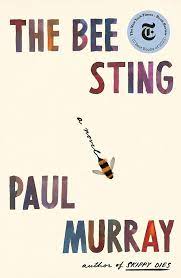The Bee Sting – A Flaming Arrow to the Heart
Paul Murray’s fourth novel, The Bee Sting, follows the Barnes family as they struggle with financial and other woes when their car dealership begins to teeter during the 2008 economic crisis. This book in one word: stung! Five stars, family drama, with an ending that is more a flaming arrow to the heart than a bee sting, a total bull’s eye! I’m still thinking about it many, many days later. For the longer version, keep reading.
This is the first novel I’ve read by Murray. He skillfully combines humor and tragedy while writing from the four different points of view of the family members. The book itself is epic in length (about 650 pages), which is why we chose it for our last Doorstoppers selection, where it received extremely positive reviews from everyone who finished it. Shortlisted for the Booker Prize in 2023, it won the Nero Award (the refashioned Costa Awards) for Fiction in January 2023.
“What Have You Done?”
At the outset the story is all character-based, a style which may not work for everyone. I found the structure engaging, though, moving as it does from long chapters spent following each of the four characters in their POV until the final section, which ramps up to an almost frenetic pace as POVs are interchanged more and more swiftly before we get to that ending. No spoilers here but let’s just say I read an interview with the author where he said that after his wife had finished reading the book, she came to him and said, “What have you done?”
Cass, the Daughter and Sister
We start with Cass, 17, finishing up high school. Murray has spoken about how it took him five years to write this novel, which started with the character of Cass. When he realized the story didn’t only concern her, he added the other family members to the mix. Cass is a young woman desperate to get out of her stifling town full of busy bodies who know your every move. Her life is Elsewhere, something More Exciting, which she hopes to experience with her best friend, Elaine. If they can only get to Dublin!
PJ, the Son and Brother
PJ, the son, is about 12 years old. My favorite character, he is quick to recite scientific facts, in awe of his older sister, and bullied by kids his own age for money he has been told his father “stole” from their parents when they were customers at the car dealership. He spends increasing amounts of time in the woods, first with a friend from school, then, later, with his dad, Dickie, and an acquaintance of Dickie’s, Victor. We see PJ exchanging messages with a friend in Dublin who continues to encourage him to run away to the city, where he assures him his mom won’t mind if PJ stays with them.
Imelda, the Wife and Mother
Long chapters don’t normally bother me but I must admit I found the third section (The Widow Bride) somewhat off-putting. I know this is primarily a reaction to the character of Imelda, Dickie’s wife and Cass and PJ’s mother. Her backstory is sad but interesting. She had a miserable upbringing as the only daughter in an almost-destitute household with a violent but overprotective, shady father; a bedridden mother; and her brothers. Her story is told in a stream-of-consciousness style, which I think was meant to reflect the kind of fractured way her mind works. Or maybe it’s a result of childhood trauma combined with current adult superficiality. The lack of punctuation combined with her narration made it somewhat hard to follow at times. If you were a fan of Ducks, Newburyport, you will probably love this section, if only for its stream-of consciousness style (by the way, Ducks, Newburyport, was fairly easy to read despite the fact that it’s several hundred pages of basically one woman’s thoughts over a period of time). Imelda’s voice, though, like those in the other sections, is extremely well-defined.
Dickie, the Husband and Father
In the fourth section, pressure mounts on the family as the business continues to flail. Dickie retreats from his family and work responsibilities as his father, Maurice, installs Big Mike, another successful town businessman (and Elaine’s father), in the dealership. Big Mike’s given the task of getting to the bottom of the problems. Unable to cope with the scrutiny and unable to be honest with himself and others in the family, Dickie spends more and more time with PJ and Victor, the local conspiracy theorist and survivalist. They begin working on a bunker in a lush and peaceful setting in the woods adjacent to the family home. When a huge amount of money is discovered to be missing from the books, we wonder if Ryszard, a Polish worker who has been helping Dickie at the garage, is responsible for the theft.
Families are Tricky
There are so many topics this book touches on, but at its core it’s about family, and families are tricky. The car dealership’s success seems to be what has kept Dickie and Imelda’s relationship, and therefore the Barnes family, on a somewhat even keel. Once the financial woes start, the tribal boat begins to list. Choices made by family members (namely Imelda and Dickie) long ago telescope out into the future, and everything goes haywire. The kids have their own lives, of course, but naturally those affect Imelda’s and Dickie’s decisions, too, with sometimes comic results. After Cass has told her father about the negative impact cars have on the environment, he begins to ride a bicycle to work, much to Imelda’s great chagrin. Xenophobia is another major theme, with Ryszard the catalyst (apologies, but I couldn’t resist!).
That Ending!
Highly readable, with appealing characters and such an empathetic treatment by Murray. These are people you know — maybe you’re one of them. I just sunk into this story and was happy to swim around in it, and I would read it again. As you probably know by now, I’m not much of a re-reader, so this is saying a lot. Certain aspects of it reminded me of A Little Life, by Hanya Yanagihara (some stylistic, some emotional), which I say as a compliment. One of the Doorstoppers members said that, for her, The Bee Sting is a “complete novel,” and I would agree. But, oh, that ending! I still don’t know what to make of it. Please, if you’ve read the book, let me know what you thought about it. Did it affect you as much as it did me? And have you read any of Paul Murray’s other books? Let me know in the comments below.
Pulling at Threads is my occasional newsletter. It always accompanies my blog posts but I sometimes send infrequent updates on other goings on. If you want more of an “insider’s” view on what’s happening in my reading and writing life, you can sign up here.


